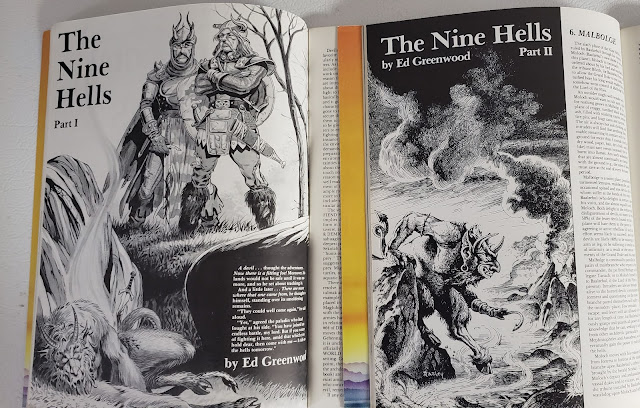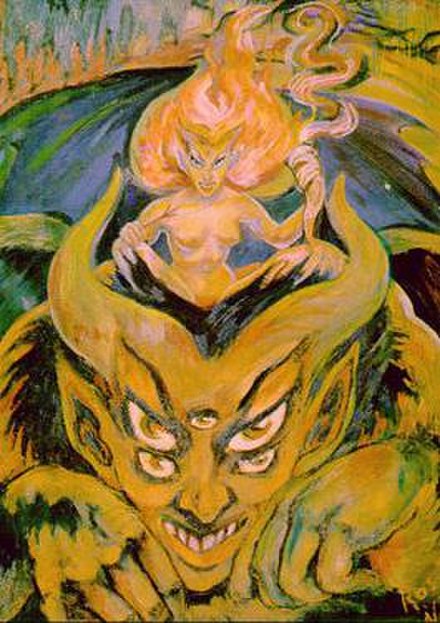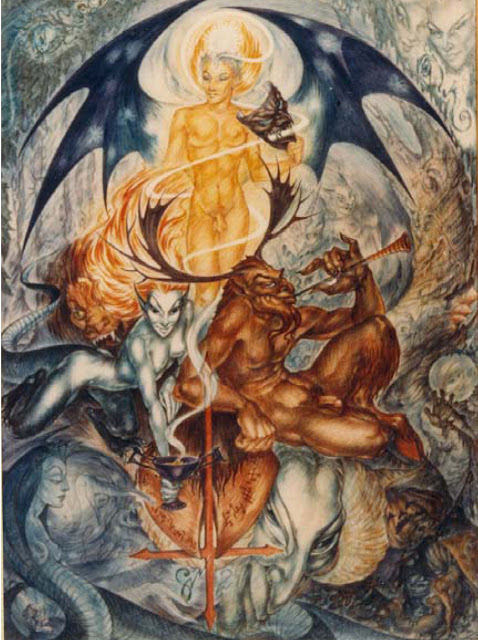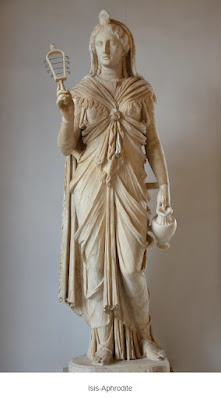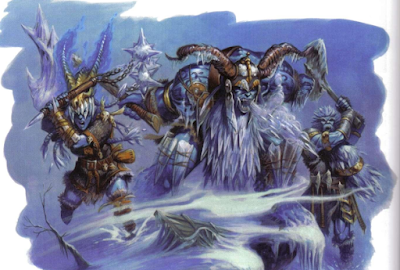It's the last full week of Halloween (October to you mundanes out there) so what better topic than the go over all of the Devils that have appeared in the pages of Dragon Magazine.
This Retrospective could go on for a long time, so I think I am going to limit myself to mostly 1st Edition treatments. Thanks to TSR bowing to the moral panic of the time we got exactly one article about Devils proper that I can find for the 2nd Ed days. They pick back up for D&D 3rd Ed, but that is getting beyond the scope of "This Old Dragon."
"The Dragon" Days
These were some of the earliest discussions on the Devils and the Nine Hells. They typically coincide with the release of the AD&D 1st Edtion Monster Manual when we introduced devils to D&D for the first time. Demons had already been added in Eldritch Wizardry for OD&D and had become a staple as these articles show. This also set the divide of Chaotic Evil Demons and Lawful Evil Devils that persists to this day. But before we get to devils proper, let's have a look at some early articles on Demons.
The Dragon #13
This issue comes to us from April 1978. This issue is notable in our discussions for two reasons. First is an ad in the back for the Monster Manual and secondly, there is the brief one-page article on Demon creation. Ok, so not devils, but the same logic could apply.
The Dragon #20
I covered this one in a proper This Old Dragon a little bit back. In this issue we have Demonology made easy; or, How To Deal With Orcus For Fun and Profit by Gregory Rihn. This expands the above article and makes it more AD&D than OD&D. Again these are demons, but the same rules can apply to devils.
The Dragon #23
This is the third attempt at a random demon system, this time from Gary himself. This one draws from the first two. Random Generation of Creatures from the Lower Planes is exactly what it says on the tin really. We should make a note here. This is for creatures of the Lower Planes, not just demons.
The Politics of Hell
Dragon #28, or more specifically for me, The Best of Dragon Vol. II gave us a landmark article that is almost entirely fluff; The Politics of Hell by Alexander von Thorn. Mr. von Thorn's only other contribution to Dragon would be 10 issues later with some skill for Traveller. He continued working, mostly on GURPS, and is still active online.
This was a landmark article that among other things it lets us know why Asmodeus, a lesser demon from the Tobit originally, was the ruler of Hell and where Satan was. The mythology presented here is extremely Judeo-Christian, so that may or may not work for a lot of games and gamers. It did however introduce me to Astaroth and by extension Astarte.
Dragon #42 would make a good choice for a future This Old Dragon. I'll have to see if I have it in my big old box of Dragons. This is the October 1980 Halloween-themed issue and has a few articles on Devils and even features on of the most famous pictures of Orcus ever.
The article "Demons, Devils and Spirits" comes to us first from Tom Moldvay. This one features four new spirits that are Lawful Good, Neutral, Chaotic Evil, and Lawful Evil. So a full house! Ashleigh Parker is next with The Possessors, or demons that can possess others. Lewis Pulsipher wraps it up with Patron Demons, a forerunner to what we will see in warlock pacts
The Nine Hells by Ed Greenwood
Not since Dragon #28's The Politics of Hell did Devils and Nine Hells get as much attention as they did in the pages of Dragons #75 and #76. There is a faint hint of the Realms here, but not so much that I felt this was world-specific. In fact, in the summer of 1983, we were still a couple more years away from the Forgotten Realms being a thing for the rest of us.
These two articles cover every layer of the Nine Hells in descending order and discuss the Dukes that rule them, their consorts, their advisors, and even some of the other devils that can be found here. There are shades of Dante's Inferno here but this is pure D&D.
This series casts such a long shadow that one would be forgiven if they forgot that Gary opened the series with the Devils that would appear in the upcoming Monster Manual II. This includes the Abishai devils, which are the spawn of Tiamat. Even though in my personal campaigns I have taken Tiamat out of Hell, the Abishai remain and are still her spawn.
Combining these we can see there is a certain level of world-building that has gone on past the publications of books like the Deities & Demigods. In particular, all non-Devil Gods have been kicked out of the Hells. I took this a step further and even removed Tiamat and placed her on her own plane.
The articles are long and just filled with great information. It would not be until the later AD&D 2nd Ed years that we would get this much detail on Devils.
For Dragon #400, Wizards reprinted the entire series, with AD&D 1st ed stats.
Dragon #91
Greenwood (and Gygax) are back a little more than a year later. Gary has a revised Goristro demon from Monster Manual II. But the big news is Ed has more Nine Hells with some details left out of the original series. It is quite a long one to be honest. Of note for me there is a devil "Gargoth" that should replace "Astaroth" from the Politics of Hells article. We are told that Astaroth is a demon prince, but that is all. Astaroth/Astarte just can't catch a break at all.
This is followed by Eight Devilish Questions, something of a FAQ about devils.
Interestingly enough, this is also the issue that Ed gives us the sword that would change my campaign in very profound ways; Demonbane.
What the Hell is a Baatezu?
Dragon #223
It will be a little more than 10 years before we get anything else about Devils in the pages of Dragon. This time it is a similar article to Politics of Hell but the new Lords of the Nine only have a little connection to old lords. Some are the same like Dis, others are related, like Fierana, and others still are new or so heavily disguised they might as well be new (Levistus and the Dark Lord respectively).
Honestly, it wasn't until Wizards of the Coast bought TSR that we ever got proper Devils back. These lords though have been woven back into the history of the Devils since 3e. Even in this article the term "Devil" to mean these fiends is never used.
Final Thoughts
Doing a retrospective like this is mostly just time-filling fluff unless I want some takeaways from it all.
Cosmic Chicken
There seems to be a game of cosmic chicken going on in the early depictions of devils. While there are some that are different in their mythological origins, Geryon from Dante's Inferno and the Erinyes from Roman Myth to name two, the vast majority of these creatures, especially the ones in Dragon, are from Judeo-Christian sources. That is of course except for The Devil himself. The authors are willing to pour through all the Medieval demonologies for names, but when it comes to Satan they blink. That is except for one article. I get it. There is a lot of baggage with "The Devil" both for religious and cultural reasons. If you are going to mine "The Inferno" and "Paradise Lost" then why leave out one of the main characters?
Though I will admit I have also struggled in using the Big D in my games, only because it needs to be something special.
Worlds Apart
While a lot of "game rules" can be applied to both demons and devils equally, I am reminded in this retrospective that they are not, and should not be the same. So while I was mentally looking over the differences and resorting (something that D&D 4e tried to do as well and met with some successes but most criticism from the fans) them into different categories, one category began to show itself in a surprising way.
Gary was better at creating demons and demon-like devils, Ed Greenwood was better at devils. So for this reason I have decided that in my games demons take a larger interest in the world of Oerth (Greyhawk) and devils take more of an interest in the world of Toril (Forgotten Realms). There are some exceptions of course. Orcus has tried to make headway into the Realms many times. But generally speaking in the games I have run and the D&D novels I have read, this seems to hold true.




